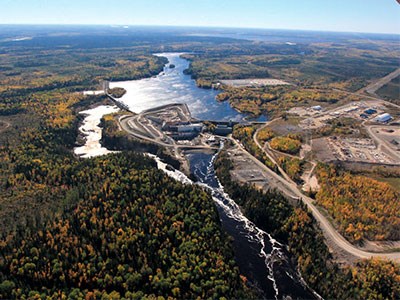Northern Ontario's largest hydro project in 40 years is on track to be completed by its June 2015 deadline, said its director.
Ontario Power Generation's (OPG) Lower Mattagami River Project is expected to increase its power- generating capacity by 438 megawatts once units are added to its four stations.
“I think it has been a very good news story for Northern Ontario,” said the project's director, Richard Jessop.
With a price tag nearing $2.6 billion, the project will employ up to 1,600 workers at peak periods. In addition to construction firms, it has also provided opportunities for engineering firms and equipment manufacturers.
When the Mattagami River power stations were built in the early 1960s, OPG left the potential for additional head-gate capacity that was not used at the time.
It was not until the early 1990s that OPG had the opportunity to buy land from the Spruce Falls Pulp and Paper company to rebuild the Smoky Falls generating station at a far greater capacity. The original generating station was built in 1926, and had a capacity of 52 megawatts. Its larger replacement will increase that capacity to 267 megawatts.
After the land was purchased, it still took more than a decade before the project was approved. “In the early 1990s there was a retraction in the economy and there was really no need for the additional capacity,” Jessop said.
In the mid-2000s the need for additional capacity had arrived, and OPG met with the nearby Moose Cree First Nation to ratify an agreement and partnership that would benefit both parties.
Through those negotiations Moose Cree First Nation gained a 25 per cent stake in the project.
“This project and the agreement we signed with OPG is a real role model for any First Nation in the country,” said Moose Cree Chief Norm Hardisty Jr.
OPG has hired nearly 200 people from Moose Cree to work on the construction project. Between 60 and 70 per cent of the total workforce is also from Northern Ontario.
“It's a good problem to have when people start saying, 'I never had money and I don't really know what to do with it,'” Hardisty said.
In 2008, members of Moose Cree First Nation consulted extensively with OPG to ensure the surrounding environment was protected as much as possible, and residents would see economic benefits after the new and improved generating stations were up and running.
With its 25 per cent stake in the project, the first nation will receive a portion of the revenues it generates.
Jessop said OPG is on schedule to complete the Little Long portion of the project first by the end of the year. The Harmon generating station will be next, followed by Smoky Falls and Kipling. Once the project is completed the generating stations will directly employ about 600 people with a maximum of 800 people during peak periods.
The Lower Mattagami River Project will provide peaking power for the province to meet higher energy demands during the dinner hour.
It will complement the baseload power the province's nuclear power stations generate and the intermediate power from wind turbines.
Jessop said the project has fallen within its allocated budget so far.




